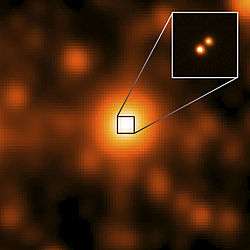Kepler-91b
Kepler-91b is a giant planet orbiting Kepler-91, a star slightly more massive than the Sun. Kepler-91 has left the main sequence and is now a red giant branch star.
| Discovery | |
|---|---|
| Discovery date | 2013 |
| Transit (Kepler Mission) | |
| Orbital characteristics | |
| 0.072+0.007 −0.002 AU | |
| 6.24658 d | |
| Inclination | 68.5+1.6 −1 |
| Star | Kepler-91 |
| Physical characteristics | |
Mean radius | 1.322+0.094 −0.086 RJ |
| Mass | 0.88+0.33 −0.17 MJ |
Mean density | 0.44 g/cm3 (0.016 lb/cu in) |
| Albedo | 0.39 [1] |
| Temperature | 2132 K |
Discovery and further confirmation
Kepler-91b was detected by analyzing the data of Kepler spacecraft where a transit-like signal was found. Initially thought to be a false positive due to light curve variations by a self-luminous object, it was later revealed that due to low density of Kepler-91's shape is distorted to slightly ellipsoidal shape due to gravitational effects of the planet. Ellipsoidal light variations caused by Kepler-91b constitute more than the third of light variations compared to transit depth. Ellipsoidal light variations also allowed to determine the planet's mass. It was also found that Kepler-91b reflects some of the starlight from its star.[2]
Further analysis managed to question the planetary nature of the object, suspecting that it is a self-luminous object[3]. However, the planetary nature was eventually confirmed again through both the radial velocity technique[4] and re-analysis of the light curve modulations[5].
Characteristics
Kepler-91b is about 14% less massive than Jupiter while being more than 35% larger, making it less than half of the density of water. Kepler-91b orbits around the host star in about 6.25 days. Despite being one of the least edge-on orbits relative to Earth with inclination being about 68.5 degrees, transit was detected due to low semi-major axis to host star radius ratio.
Kepler-91b is expected to be engulfed by the parent star within about 55 million years.[2][1]
Possible trojan companion
The possibility of a trojan planet to Kepler-91b was suggested due to the presence of a small dim in the phase-folded light curve at phase 0.68[2]. This was subsequently studied but the conclusion was that the transit-signal was a false-positive.[6]
References
- Esteves, Lisa J.; De Mooij, Ernst J. W.; Jayawardhana, Ray (2014). "Changing Phases of Alien Worlds: Probing Atmospheres of Kepler Planets with High-Precision Photometry". The Astrophysical Journal. 804 (2): 150. arXiv:1407.2245. Bibcode:2015ApJ...804..150E. doi:10.1088/0004-637X/804/2/150.
- Lillo-Box, J.; Barrado, D.; Moya, A.; Montesinos, B.; Montalbán, J.; Bayo, A.; Barbieri, M.; Régulo, C.; Mancini, L.; Bouy, H.; Henning, T. (2013). "Kepler-91b: A planet at the end of its life. Planet and giant host star properties via light-curve variations". Astronomy & Astrophysics. 562: A109. arXiv:1312.3943. Bibcode:2014A&A...562A.109L. doi:10.1051/0004-6361/201322001.
- Sliski, David H.; Kipping, David M. (2014). "A High False Positive Rate for Kepler Planetary Candidates of Giant Stars using Asterodensity Profiling". The Astrophysical Journal. 788 (2): 148. arXiv:1401.1207. Bibcode:2014ApJ...788..148S. doi:10.1088/0004-637X/788/2/148.
- Lillo-Box, J.; Barrado, D.; Henning, Th.; Mancini, L.; Ciceri, S.; Figueira, P.; Santos, N. C.; Aceituno, J.; Sánchez, S. (August 2014). "Radial velocity confirmation of Kepler-91 b". Astronomy & Astrophysics. 568: L1. arXiv:1408.1528. doi:10.1051/0004-6361/201424587. ISSN 0004-6361.
- Barclay, Thomas; Endl, Michael; Huber, Daniel; Foreman-Mackey, Daniel; Cochran, William D.; MacQueen, Phillip J.; Rowe, Jason F.; Quintana, Elisa V. (2015). "Radial Velocity Observations and Light Curve Noise Modeling Confirm that Kepler-91b is a Giant Planet Orbiting a Giant Star". The Astrophysical Journal. 800 (1): 46. arXiv:1408.3149. doi:10.1088/0004-637X/800/1/46. ISSN 0004-637X.
- Placek, Ben; Knuth, Kevin H.; Angerhausen, Daniel; Jenkins, Jon M. (2015). "Characterization of Kepler-91b and the Investigation of a Potential Trojan Companion Using EXONEST". The Astrophysical Journal. 814 (2): 147. arXiv:1511.01068. Bibcode:2015ApJ...814..147P. doi:10.1088/0004-637X/814/2/147.



